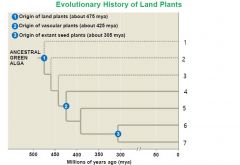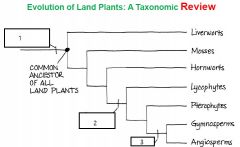![]()
![]()
![]()
Use LEFT and RIGHT arrow keys to navigate between flashcards;
Use UP and DOWN arrow keys to flip the card;
H to show hint;
A reads text to speech;
51 Cards in this Set
- Front
- Back
|
1. 3 billion 2, cyanobacteria |
Terrestrial surface of earth was lifeless for first __1__ years. __2__ existed on land 1.2 billion years ago. 500 million years ago, small plants, fungi and animals emerged on land. |
|
|
1. 290,000 2. protists 3. algae 5. oxygen 6. energy |
Land plants have diversified into roughly __1__ living species. They do not include photosynthetic __2__ also known as __3__. Plants supply __4__ and are the ultimate source of most __5__ eaten by land animals. |
|
|
1. Nitrogen 2. Carbon Dioxide 3. Oxygen |
Land plants evolved from green algae was able to fix __1__ and __2__ out of the atmosphere to create a byproduct gas __3__. |
|
|
- Rings of cellullose-synthesizing complexes - Peroxisome enzymes - Structure of flagellated sperm - Formation of a phragmoplast |
4 Key Traits of Land Plants shared with Green Algae |
|
|
Phragmoplast |
- Plant cell specific structure group of microtubules that forms during late cytokinesis. It serves as a scaffold for cell plate assembly and subsequent formation of a new cell wall separating the two daughter cells |
|
|
Sexually and Asexually |
Plants and green algae have the ability to reproduce _______________? |
|
|
Charophytes |
- Green algae that are similar to plants |
|
|
Sporopollenin |
- Layer of a durable polymer that prevents exposed zygotes from drying out, also found in walls of plant spores - In green algae |
|
|
- Unfiltered sun - Plentiful carbon dioxide - Nutrient-rich soil - Few herbivores/pathogens - Scarcity of water - Lack of structural support |
4 Factors for Movement onto Land by Ancestors of Green Algae 2 Challenges |
|
|
- Roots - Stems - Vascular System - Leaves - Stomata - Cuticle |
Adaptations made to survive on land (6) |
|
|
Embryophytes |
- Land plants that produce specialized, dependent embryo |
|
|
Red Algae - Chlorophytes - Charophytes - Embryophytes [Plantae] |
Trace ancestral algae from Red Algae to Plants (4) |
|
|
- Alternation of generations and multicellular dependent embryos - Walled spores produced in sporangia - Multicellular gametangia - Apical meristems |
4 Key Traits of Land Plants but absent in green algae |
|
|
Sporangia |
- Multicellular organ shaped like a ball of sporophytes that produces the haploid spores |
|
|
1. Mitosis 2. Haploid 3. Diploid 4. Meiosis 5. Sporophyte |
Gametophytes undergo __1__ to produce identical __2___ spores. Once they fertilize to become ___3___ zygotes, it undergoes ___4___ produce more spores and is considered a ___5___. |
|
|
Gametangia Archegonia Antheridia |
- Unique land plant feature that are multicellular organs that produce gametes Female ones have eggs and are called: Male ones have sperm and are called: |
|
|
Apical meristem |
- Although plants are immobile, their roots and shoots can elongate, increasing exposure to environmental resources. - This growth in length is sustained throughout the plant's life by the activity of the ______ which are localized regions of cell division at the tips of roots and shoots. - Form various types of internal tissues |
|
|
Alternation of generations Gametophytes and Sporophytes |
- A reproductive cycle where plants alternate between two multicellular stages - What are the two stages? |
|
|
1. Diploid 2. Gametophyte 3. placental transfer cells 4. Embryophytes |
__1__ embryo is retained within the tissue of the female ___2____. Nutrients are transferred from parent to embryo through ___3___. Land plants are called ___4____ because of the dependency of the embryo on the parent. |
|
|
Sporocytes/Sporophytes Sporangia |
- Diploid cells/Organisms that undergo meiosis to generate haploid spores - The spores are produced where? |
|
|
Sporopollen |
- Contained in the walls of spores to make them resistant to harsh environments |
|
|
Archegonia |
- Female gametangia produce eggs and are the site of fertilization |
|
|
Antheridia |
- Male gametangia that produce and releases sperm |
|
|
Cuticle |
- Waxy covering of the epidermidis |
|
|
Stomata |
- Cells that allow for gas exchange between outside air and plant |
|
|
Mycorrhizae |
- Symbiotic associations between fungi and land plants that may have helped plants without true roots to obtain nutrients |
|
|
Secondary Compounds |
- Substances produced by plants that deter herbivores and parasites - May also be used for medicinal purposes |
|
|
1. Plants 2. Spores 3. Sporangium |
Fossil evidence indicates that ___1___ were on land at least 470 million years ago. Fossilized ___2___ and tissues have been extracted from 450 million year old rocks. Fossils of larger structures, such as ___3___ date to 425 million years ago. |
|
|
- Liverworts - Mosses - Hornworts Byrophytes |
3 Ancestral Avascular Land Plants These are also called? |
|
|
Lycophytes Pterophtes |
2 Ancestral Seedless Vascular Plants |
|
|
Lycophytes |
- Latin term referring collectively to club mosses, spike mosses, quillworts |
|
|
Pterophytes |
- Latin term referring collectively to ferns, horsetails, whisk ferns |
|
|
Gymnosperms Angiosperms |
2 Extant Vascularized Seed Plants |
|
|
1. Liverworts 2. Mosses 3. Hornworts 4. Lycophytes 5. Pterophytes 6. Gymnosperms 7. Angiosperms |

|
|
|
Bryophytes |
Nonvascular plants |
|
|
Clades |
- Subgroup of plants |
|
|
- Lycophytes (Club mosses) - Monilophytes (Ferns) |
2 Clades of Seedless Vascular Plants |
|
|
Monilophytes |
- Also known as Pterophytes |
|
|
Seed |
- Embryo and nutrients surrounded by a protective coat of carbohydrates |
|
|
Gymnosperms Angiosperms |
2 Clades of Vascular Seed Plants |
|
|
Gymnosperms |
- "Naked seed" plants including the conifers |
|
|
Angiosperms |
- Flowering plant |
|
|
1. Multicellular gametangia 2. Vascular tissue 3. Seeds |

|
|
|
Xylem Phloem |
2 Types of Vascular Tissue |
|
|
Xylem |
- Conducts most of the water and minerals and includes dead cells called tracheids |
|
|
Tracheids |
- Type of water conducting cell that are longer and thinner with tapered ends - Their secondary walls are hardened with lignin |
|
|
Lignin |
- Strengthen water-conducting cells and provide structural support |
|
|
Phloem |
Consists of living cells and distributes sugars, amino acids, and other organic products- |
|
|
Roots |
- Organs that anchor vascular plants - Enable them to absorb water and nutrients from the soil |
|
|
Leaves |
- Increase surface area for plants to capture solar energy and undergo photosynthesis |
|
|
Microphylls Megaphylls |
Two Types of Leaves: - Leaves with a single vein - Leaves with a highly branched vascular system |

